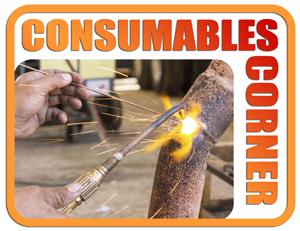Independent welding consumables professional
- FMA
- The Fabricator
- FABTECH
- Canadian Metalworking
Categories
- Additive Manufacturing
- Aluminum Welding
- Arc Welding
- Assembly and Joining
- Automation and Robotics
- Bending and Forming
- Consumables
- Cutting and Weld Prep
- Electric Vehicles
- En Español
- Finishing
- Hydroforming
- Laser Cutting
- Laser Welding
- Machining
- Manufacturing Software
- Materials Handling
- Metals/Materials
- Oxyfuel Cutting
- Plasma Cutting
- Power Tools
- Punching and Other Holemaking
- Roll Forming
- Safety
- Sawing
- Shearing
- Shop Management
- Testing and Measuring
- Tube and Pipe Fabrication
- Tube and Pipe Production
- Waterjet Cutting
Industry Directory
Webcasts
Podcasts
FAB 40
Advertise
Subscribe
Account Login
Search
Consumables Corner: Simple steps to avoid cracking
- By Nino Mascalco
- June 25, 2014
- Article
- Consumables
Q: When welding a thick section of a forged 4130 ring to a thinner A36 plate in a T-joint configuration, we experience longitudinal cracking issues that originate from the ends of the welds. The required fillet size is ½ inch. It is skip-welded 12 in. on 18-in. center-to-center spacing. The material is being preheated to 250 degrees F and welded in the 2F position with two passes of 1/16-in.-dia. E71T-1 flux-cored wire and 100 percent CO2 shielding gas. How can we prevent this cracking?
A: The preheat temperature that you are using on the 4130 material is too low for heavier sections. When the preheat temperature is too low, the weld cools too quickly, which produces an undesirable microstructure that is prone to cracking. If the material is more than 1 in. thick, your preheat and interpass temperatures should be between 400 and 600 degrees F. Also, you will want to slow down the cooling process by covering the weld area with a fireproof insulation or heavy blanket immediately after welding.
The problem with two passes for a ½-in. weld is the first weld bead is typically focused on the flat part of the joint and doesn’t allow for sufficient penetration at the root. Additionally, to get the required ½-in. weld, you have to decrease the travel speed to allow the weld bead to build up, which typically leads to a heat input above recommended values.
Instead, use a true multipass technique to reach the required ½-in. fillet size. To do this, run one weld bead directly where the two pieces of metal meet at the root of the T-joint, and then weld corresponding layers using multiple passes to build up the weld from the flat to vertical material.
Each individual weld bead should be no wider than the requirements for a ¼-in. to 5/16-in. weld bead. Since this is typically a slag-producing process, drag the weld along at about a 30-degree angle and use a 40-degree work angle.
Also, be sure to leave the craters of the weld in the middle of the weld bead rather than at the weld ends, which will help eliminate crater cracking.
Since you are welding in the 2F position, I recommend changing to an E70T-1 wire. This will improve your bead appearance, profile, and weld-toe wetting to help reduce stresses in the weld.
About the Author

About the Publication
Related Companies
subscribe now

The Welder, formerly known as Practical Welding Today, is a showcase of the real people who make the products we use and work with every day. This magazine has served the welding community in North America well for more than 20 years.
start your free subscription- Stay connected from anywhere

Easily access valuable industry resources now with full access to the digital edition of The Fabricator.

Easily access valuable industry resources now with full access to the digital edition of The Welder.

Easily access valuable industry resources now with full access to the digital edition of The Tube and Pipe Journal.
- Podcasting
- Podcast:
- The Fabricator Podcast
- Published:
- 04/16/2024
- Running Time:
- 63:29
In this episode of The Fabricator Podcast, Caleb Chamberlain, co-founder and CEO of OSH Cut, discusses his company’s...
- Trending Articles
Sheffield Forgemasters makes global leap in welding technology

Welding student from Utah to represent the U.S. at WorldSkills 2024

Lincoln Electric announces executive appointments

Lincoln Electric acquires RedViking

Engine-driven welding machines include integrated air compressors

- Industry Events
16th Annual Safety Conference
- April 30 - May 1, 2024
- Elgin,
Pipe and Tube Conference
- May 21 - 22, 2024
- Omaha, NE
World-Class Roll Forming Workshop
- June 5 - 6, 2024
- Louisville, KY
Advanced Laser Application Workshop
- June 25 - 27, 2024
- Novi, MI



























